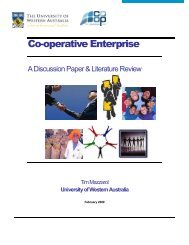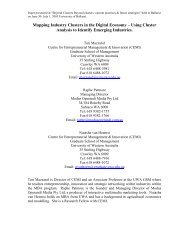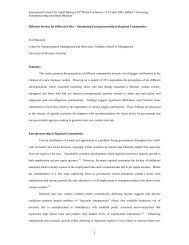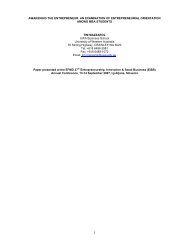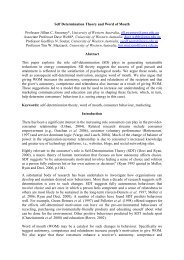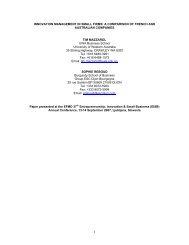The Future of Farming: Strategic Intent, Technology Diffusion ... - CEMI
The Future of Farming: Strategic Intent, Technology Diffusion ... - CEMI
The Future of Farming: Strategic Intent, Technology Diffusion ... - CEMI
You also want an ePaper? Increase the reach of your titles
YUMPU automatically turns print PDFs into web optimized ePapers that Google loves.
Centre for Entrepreneurial Management and Innovation<strong>The</strong> <strong>Future</strong> <strong>of</strong> <strong>Farming</strong>: <strong>Strategic</strong> <strong>Intent</strong>, <strong>Technology</strong> <strong>Diffusion</strong> and Precision Farm Management7seasonal conditions are not within the control <strong>of</strong> the wool producer but need to be managed effectively forpr<strong>of</strong>itability and sustainability. Sensitivity to seasonal conditions and commodity prices may provide someclues as to whether producer’s are likely to adopt an innovation as, the more sensitive the enterprise is toexternal forces, the greater the need to adopt innovative practices to overcome production and market risk(Chapman and MacMillan 2000).All cases were sensitive to external conditions but seasonal conditions were most likely to affect case one andcase two because they were farming as close to maximum pasture utilisation as possible within their existingenterprise structure. <strong>The</strong>se enterprises had sought to maximise pasture utilisation by increasing stocking ratesbeyond the district average (case one) or by rotating livestock frequently for maximum grazing coverage (casetwo). <strong>The</strong>refore late season breaks or poor winter rains may leave these farms without access to feed for theirstock.All four cases were affected by the fluctuating price for fine wool but each had adopted a slightly differententerprise structure in response to this situation. Case three had committed to a long-term breeding programaimed at growing finer, higher value wool fibre, making the wool enterprise vulnerable to price fluctuations inthe fine end <strong>of</strong> the wool market. However, this reliance on the price <strong>of</strong> fine wool was balanced by an extensivebroad acre cropping program. Case one had also introduced cropping into their farm system. This approachwas used to reduce market risk in terms <strong>of</strong> shifting reliance away from wool income and also production risk interms <strong>of</strong> providing additional feed for livestock during the summer months. In contrast case two and case fourhad been able to counter volatile market conditions by diversifying into prime lamb and sheep meatproduction and maintaining a medium wool merino flock. <strong>The</strong>re was a greater felt need for remotely sensedpasture management information among case studies with high stocking rates or rotational grazing systemsthan those with fine wool breeding programs and large meat enterprises. This may be because <strong>of</strong> the greaterreliance that these producers have on converting pasture into pr<strong>of</strong>itable wool fibre.All four cases had limited access to farm labour and considered themselves ‘time-poor’. Case two haddeliberately moved towards a less labour intensive operation to reduce labour costs and to free up more <strong>of</strong>the farm family’s time, therefore labour saving technologies were highly valued by this producer. In case three,the producer felt that he was constrained by a lack <strong>of</strong> time to trial new ideas and was concerned about thedifficulties <strong>of</strong> employing good quality labour. <strong>The</strong> lack <strong>of</strong> access to on-farm labour is a problem for many woolproducers and has been attributed to poor pr<strong>of</strong>itability and returns on investment (Beare 1999) and to thegeneral increase in farm size (Craik 2000). Without the being time available to trial and evaluate innovations itis unlikely that the case study producers would be able to adopt new technologies.While cases one, three and four used the Internet to access a range <strong>of</strong> information including weather andmarket data and for email communication; case two struggled to access information via the Internet due to alack <strong>of</strong> knowledge. Although this producer had access to both a computer and the Internet on the farm lack <strong>of</strong>computer skills and confidence with these technologies acted as a major barrier to use. Although three out <strong>of</strong>four <strong>of</strong> the case study producers were comfortable accessing data via the Internet, without adequate trainingit is unlikely that producers like case four would be able to use technologies such as FOO and PGR delivered viathe Internet.THE INFLUENCE OF TASK NETWORKSTask networks are made up <strong>of</strong> customers, suppliers, colleagues and employees (Gibb 1996). <strong>The</strong> attitude <strong>of</strong>producers towards innovations can act as a major constraint in the adoption <strong>of</strong> innovations (Guerin and Guerin1994); producers tend to work closely together in producer groups and are likely to be influenced by theattitudes <strong>of</strong> their peers. <strong>The</strong> level <strong>of</strong> influence that task networks have over producers depends upon theCentre for Entrepreneurial Management and Innovation | www.cemi.com.au



